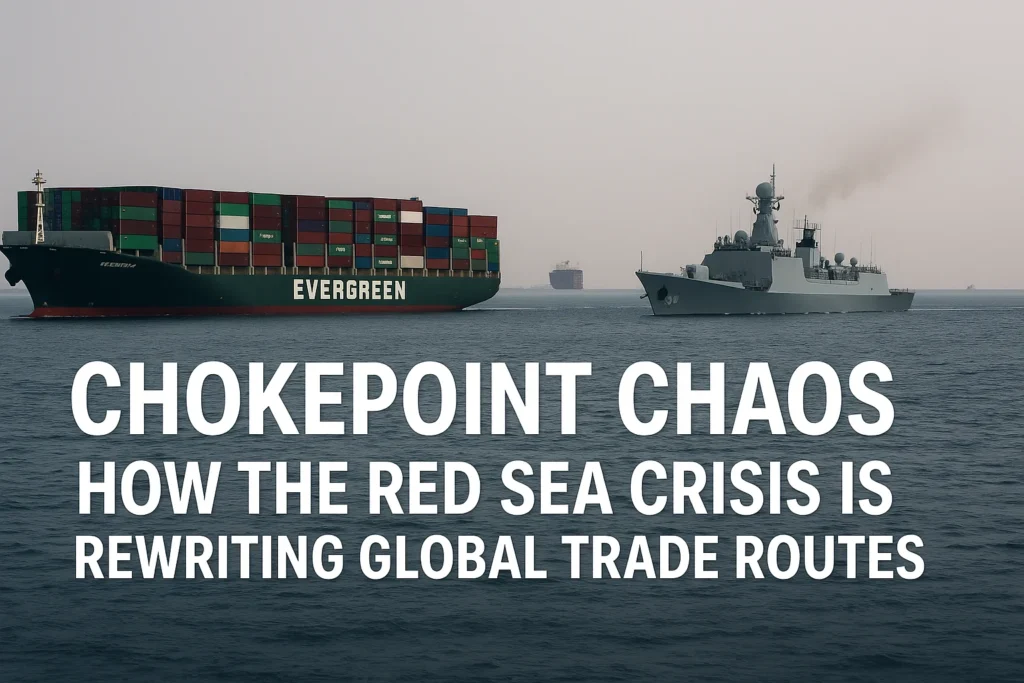Section 1: The Critical Importance of the Red Sea Shipping Lane
Geographic and Economic Significance
The Red Sea has served as a vital maritime artery connecting Europe and Asia for centuries, with its importance dramatically increasing after the 1869 opening of the Suez Canal. This artificial waterway revolutionized global trade by:
- Reducing the London-Bombay voyage distance by 41% (5,700 nautical miles)
- Cutting transit time between Asia and Europe by 10-15 days
- Enabling larger vessels than could navigate alternative routes
Today, the Red Sea-Suez Canal corridor handles:
- 12-15% of total global trade volume annually
- 30% of all container ship traffic worldwide
- 8-10% of global oil shipments
- 12% of liquefied natural gas (LNG) exports
The Bab el-Mandeb Chokepoint
The southern entrance to the Red Sea presents a critical vulnerability:
- Narrowest point: Just 18 miles wide between Yemen and Djibouti
- Daily traffic: 50-60 major commercial vessels
- Strategic value: Considered one of world’s seven crucial maritime choke points
Section 2: Origins and Escalation of the Current Crisis
Historical Roots of Regional Tensions
The present conflict stems from multiple interwoven geopolitical issues:
- Yemen’s Ongoing Civil War (2014-present)
- Houthi rebel control of western Yemen including key coastal areas
- Saudi-led coalition intervention since 2015
- Humanitarian crisis with widespread food insecurity
- Regional Power Struggles
- Iran-Saudi Arabia proxy conflicts
- Competition for influence in the Horn of Africa
- Rivalry over control of critical shipping lanes
- Broader Middle East Tensions
- Israel-Palestine conflict spillover effects
- U.S. military presence in the region
- Competition over energy exports
Chronology of the Shipping Crisis
2023:
- November 19: Houthis seize Galaxy Leader cargo ship
- December 3: First missile attacks on commercial vessels
- December 15: Major shipping lines begin route diversions
2024:
- January 12: U.S. launches Operation Prosperity Guardian
- February 1: Suez Canal traffic drops below 50% of normal
- March 15: Insurance premiums reach 1.5% of cargo value
Section 3: Comprehensive Impact on Global Supply Chains
Shipping Industry Transformations
The crisis has forced dramatic changes in maritime operations:
- Route Diversions
- 90% of container ships avoiding Red Sea
- Average detour adds 3,500 nautical miles (10-14 days)
- Cape of Good Hope traffic increases 300%
- Fleet Management Challenges
- Vessel utilization rates drop from 85% to 65-70%
- Schedule reliability falls to 35% from 65% pre-crisis
- Crew rotation and welfare issues emerge
- Financial Impacts
- Daily operating costs increase by $20,000-$30,000 per vessel
- Bunker fuel consumption rises 35-40%
- Charter rates for suitable vessels spike
Cost Structure Changes
Detailed breakdown of increased expenses:
| Cost Factor | Pre-Crisis Level | Current Level | Percentage Increase |
|---|---|---|---|
| Asia-Europe Freight | $1,500/FEU | $6,000/FEU | 300% |
| War Risk Insurance | 0.1% cargo value | 1.0-1.5% cargo value | 900-1400% |
| Bunker Fuel Costs | $600/ton | $750/ton | 25% |
| Crew Hazard Pay | Base salary | +50-100% | 50-100% |
| Security Equipment | Minimal | $50,000-$100,000/ship | N/A |
Section 4: Industry-Specific Consequences and Adaptations
Automotive Sector Disruptions
The crisis has particularly impacted global automakers:
- Production Disruptions
- European plants experience 5-7 day stoppages
- North American factories face parts shortages
- Just-in-time inventory systems prove vulnerable
- Cost Increases
- $500-$1,200 added per vehicle
- 8-12% increase in logistics budgets
- Margins compressed 3-5 percentage points
- Strategic Responses
- Increased air freight for critical components
- Development of alternative supplier networks
- Inventory buffer stock increases
Energy Market Turbulence
The crisis has created significant challenges for energy markets:
- Oil Market Impacts
- $5-$8 per barrel risk premium
- 15-20% of Europe-bound oil shipments diverted
- Increased volatility in crude prices
- LNG Sector Challenges
- Qatari exports to Europe delayed 10-14 days
- Spot prices show increased regional disparities
- Charter rates for LNG carriers rise 50-75%
- Alternative Energy Routes
- Increased use of SUMED pipeline
- Consideration of African land bridges
- Expanded West African loading options
Section 5: Comprehensive Military and Diplomatic Responses
Operation Prosperity Guardian Analysis
The U.S.-led naval coalition faces complex challenges:
- Force Composition
- 22 participating nations with varying commitments
- 5-7 major surface combatants typically on station
- Airborne surveillance and drone defenses
- Operational Challenges
- Vast area of operations (1.2 million square miles)
- Difficulties distinguishing threats from civilian traffic
- Limited rules of engagement constraints
- Effectiveness Assessment
- Attack frequency reduced but not eliminated
- Significant insurance premium impact remains
- Commercial shipping confidence still low
Alternative Security Measures
Industry-led protective measures:
- Defensive Equipment
- Laser dazzlers and anti-drone systems
- Water cannon installations
- Enhanced bridge protection
- Operational Changes
- Increased speeds through high-risk zones
- Nighttime transits when possible
- Enhanced watchkeeping procedures
- Private Security
- 45% increase in armed guard deployments
- New specialized training programs
- Escort vessel services emerging
Section 6: Regional Economic Consequences
European Economic Impacts
The crisis has created significant headwinds for Europe:
- Macroeconomic Effects
- 0.5-1.2% GDP growth reduction estimates
+0.7% inflationary pressure from imports - 5-8% decline in manufacturing output
- Sector-Specific Challenges
- Automotive: Production disruptions
- Retail: Inventory shortages
- Energy: Higher input costs
- Policy Responses
- Emergency logistics funding
- Strategic stockpile releases
- Trade finance support
Asian Economic Consequences
Export-dependent Asian economies face new challenges:
- Export Sector Pressures
- 15-25% higher logistics costs
- 3-5 week delivery delays
- Contract renegotiation demands
- Manufacturing Impacts
- Production scheduling difficulties
- Increased working capital needs
- Workforce management challenges
- Currency and Financial Effects
- Export currency depreciation
- Increased hedging costs
- Supply chain finance strains
Section 7: Strategic Industry Adaptations
Short-Term Mitigation Strategies
Businesses are implementing various temporary solutions:
- Transportation Alternatives
- 40% increase in air freight utilization
- Reactivation of laid-up vessels
- Intermodal solutions combining sea-air
- Inventory Management
- 25-30% buffer stock increases
- Safety stock level reviews
- Warehouse network reconfiguration
- Commercial Adjustments
- Force majeure declarations
- Contract renegotiations
- Surcharges and price increases
Long-Term Structural Changes
The crisis is accelerating several transformative trends:
- Supply Chain Restructuring
- Nearshoring to Turkey/Eastern Europe
- China+1 sourcing strategies
- Regional supply chain development
- Logistics Network Redesign
- Multi-route contingency planning
- Port and corridor diversification
- Inventory positioning changes
- Business Model Innovations
- Vertical integration increases
- Collaborative logistics platforms
- Circular economy approaches
Section 8: Emerging Technological Solutions
Maritime Innovations
New technologies are being deployed to address challenges:
- Vessel Technologies
- Autonomous navigation systems
- Alternative fuel propulsion
- Enhanced monitoring equipment
- Security Technologies
- Drone detection systems
- Non-lethal defense mechanisms
- Cybersecurity enhancements
- Operational Technologies
- Real-time threat monitoring
- Dynamic routing algorithms
- Predictive analytics tools
Supply Chain Technologies
Digital solutions are gaining importance:
- Visibility Platforms
- Blockchain-enabled tracking
- IoT sensor networks
- Digital twin implementations
- Planning Systems
- AI-driven demand forecasting
- Risk simulation modeling
- Scenario planning tools
- Execution Systems
- Dynamic transportation management
- Multi-modal optimization
- Exception management platforms
Section 9: Future Scenarios and Projections
Potential Resolution Pathways
Experts outline several possible outcomes:
- Swift Resolution Scenario
- Diplomatic breakthrough within 6 months
- Gradual return to normal operations
- Lasting insurance premium impacts
- Protracted Conflict Scenario
- 2-3 year disruption period
- Permanent trade route changes
- Significant supply chain restructuring
- Escalation Scenario
- Regional conflict expansion
- Energy market disruptions
- Global economic consequences
Long-Term Industry Impacts
Potential lasting changes to global trade:
- Route Diversification
- 10-20% permanent Suez traffic reduction
- Cape route capacity investments
- Arctic route development acceleration
- Supply Chain Evolution
- Increased regionalization
- Inventory strategy changes
- Supplier network expansion
- Risk Management Transformation
- Enhanced contingency planning
- Political risk assessment upgrades
- Insurance product innovations
Section 10: Lessons for Global Trade Resilience
Risk Management Framework Enhancements
Key improvements needed in supply chain risk management:
- Vulnerability Assessment
- Chokepoint mapping
- Single-point-of-failure analysis
- Stress testing exercises
- Mitigation Planning
- Alternative route development
- Buffer capacity planning
- Emergency protocols
- Response Capabilities
- Crisis management teams
- Decision-making frameworks
- Communication systems
Policy Recommendations
Suggested governmental and institutional responses:
- International Cooperation
- Maritime security frameworks
- Conflict resolution mechanisms
- Information sharing platforms
- Infrastructure Investment
- Port capacity expansion
- Alternative route development
- Digital infrastructure
- Regulatory Adjustments
- Insurance market reforms
- Contingency planning mandates
- Trade finance support
Conclusion: Rethinking Globalization in an Age of Disruption
The Red Sea shipping crisis represents more than a temporary supply chain disruption—it serves as a wake-up call about the vulnerabilities inherent in our highly interconnected global trading system. The event has exposed critical weaknesses in just-in-time production models, over-reliance on specific geographic chokepoints, and inadequate contingency planning for geopolitical risks.
As the situation continues to evolve, several key insights emerge:
- The globalization model that dominated the early 21st century requires fundamental reassessment to incorporate greater resilience and redundancy.
- Regional conflicts can no longer be contained geographically—their economic consequences inevitably ripple through global systems.
- Technological solutions, while helpful, cannot alone address systemic vulnerabilities created by geopolitical tensions.
- Both businesses and governments must develop more robust, flexible systems capable of withstanding such disruptions.
The ships now making their long detours around Africa carry more than just cargo—they represent the urgent need to reimagine global trade architectures for an era of increasing uncertainty. The ultimate resolution to the current crisis will likely require a combination of military security, diplomatic solutions, and fundamental changes to how we organize global commerce. What began as a regional conflict has become a stress test for globalization itself, with lessons that will shape trade policy and business strategy for years to come.



